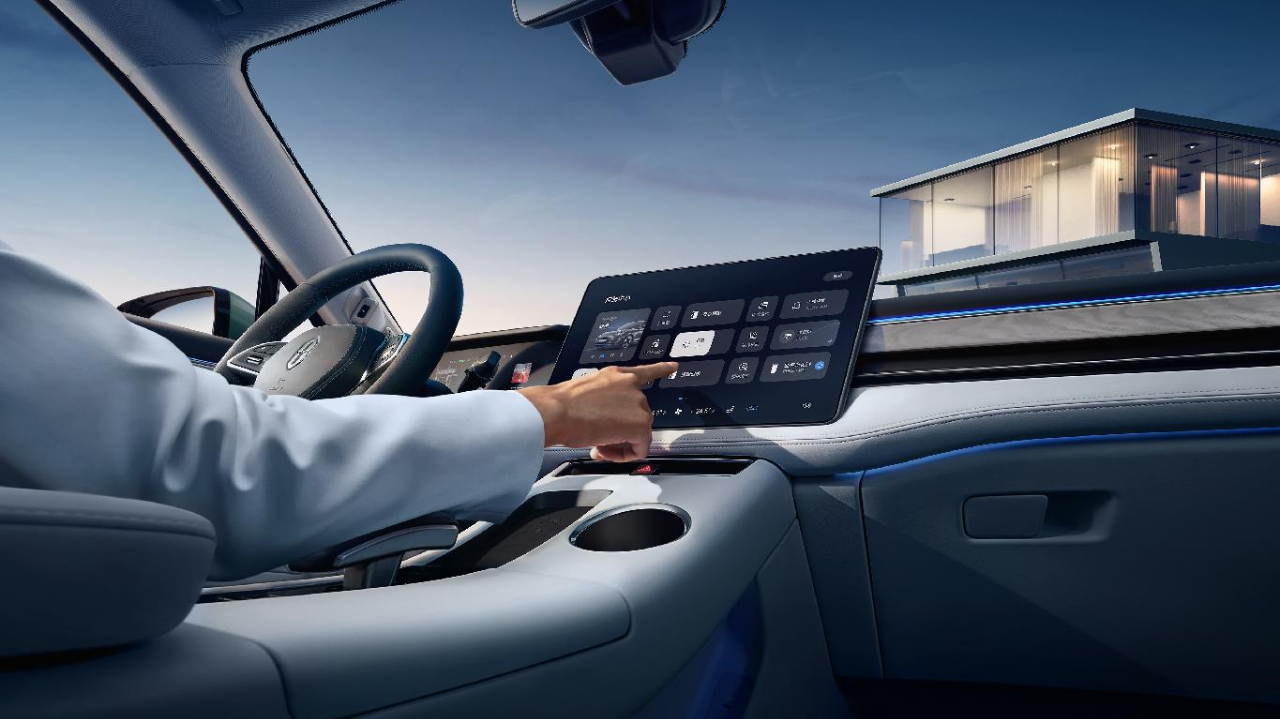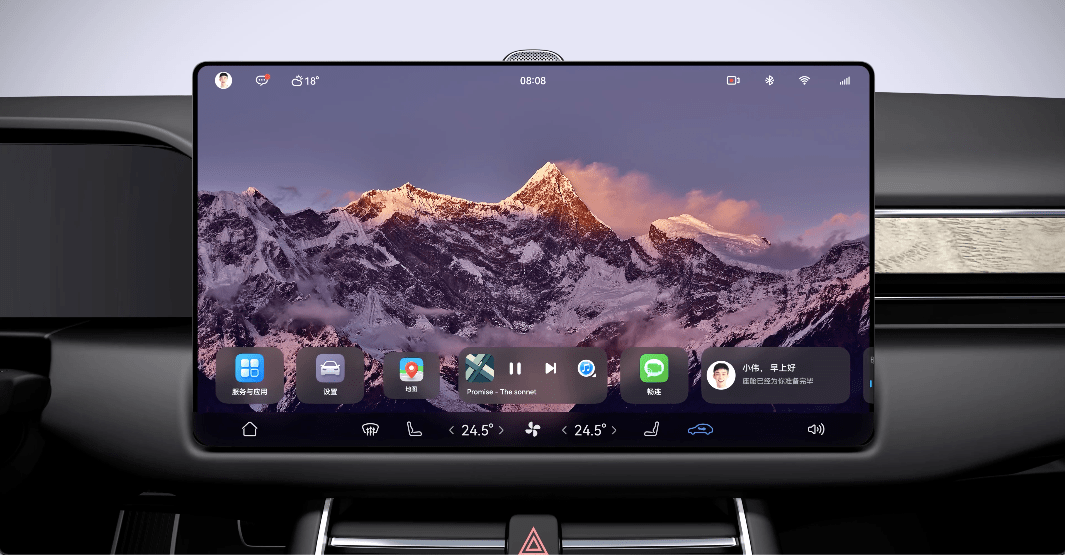60 PPT on stage, the new car model M5 EV outshines Mate phone at Huawei launch event on September 6.
Brand WENJIE achieved over 30,000 accumulative sales with only three cards: M5, M7, and HarmonyOS vehicle system since its release. In August, more than 10,000 units were sold.
WENJIE is the fastest-growing new entrant in the automotive industry by sales figures. Moreover, if WENJIE were not treated as a new player but a high-end electric vehicle brand launched by a traditional car manufacturer, it would be regarded as the second best-selling domestic high-end EV brand.
Why did this so-called “EBB copycat” with an extended range and a HarmonyOS Smart Cockpit become a phenomenal success? What was the driving force behind WENJIE’s booming sales? And most importantly, has WENJIE’s success come to stay?
HarmonyOS is the bridge connecting Huawei and WENJIE.
In the automotive industry, it is rare to see the monthly sales volume of a low-selling model increasing dozens of times simply by repackaging it. Huawei achieved that goal unexpectedly.
In April 2021, before the opening of the Shanghai auto show, the Huawei experience store on Nanjing Road began to draw the attention of interested visitors due to the appearance of an electric car on exhibit – the SF5 from SERES, which had previously appeared many times on the auto show stage.
The plug-in hybrid electric vehicle, SF5, equipped with a large-capacity lithium battery, could travel more than 150 kilometers on a single electric charge and accelerate to a speed of less than 5 seconds.
However, the SF5, with its formidable battery range and promising acceleration performance, didn’t sell well, failing to impress potential buyers.
After the vehicle became available in the Huawei experience store, its monthly sales stayed at only around hundreds of units. Feedback from insurers was even more straightforward; the average monthly sales volume was only between 200 to 300 units.
Then, how did Huawei turn SF5 into WENJIE M5, which has become a best-seller? The first step was to renovate the exterior and interior design.Translate the Chinese text in Markdown format below to English Markdown text.

In terms of appearance, the Wanjie M5 borrows the design style of the hot-selling Porsche Macan, especially in the D-pillar position, which is quite similar.

In terms of interior design, the Wanjie M5 abandons the traditional interior design of the combustion engine car of the EX5 SUV model and adopts a large screen and higher-grade leather materials, as well as consumer needs such as high-power mobile phone charging functions, that car companies are unwilling to provide.
The second step is to transfer Huawei’s brand advantage to Wanjie through the Hongmeng smart car system.
The Hongmeng car system of Wanjie M5 uses the same Hongmeng system as Huawei phones. In terms of apps and data, the Hongmeng car system of Wanjie is completely interconnected with Huawei’s Hongmeng system.

Including multimedia content in entertainment apps such as Huawei Music and Huawei Video, Huawei phone users can seamlessly enjoy entertainment content in the car through the Huawei account system.
The user experience brought by the Hongmeng car system is one aspect, but the greatest value is the transfer of Huawei’s brand value.
Without the Hongmeng car system, Wanjie would be just like EX5, just a car brand sold in Huawei experience stores. With the Hongmeng car system, the Wanjie brand is connected with the Huawei brand through the Hongmeng car system.
For users, devices equipped with the Hongmeng system, even cars produced by EX5, can be forcibly linked to the Huawei brand, just like Honor phones.
In terms of product, Huawei has transformed more market demands into product configurations and has made improvements on the EX5 SUV model. In terms of brand, through the Hongmeng car system, Huawei has linked the Huawei and Wanjie brands.
Huawei’s two-step strategy has successfully shaped the Wanjie brand. The EX5 SUV model, which used to sell only a hundred units a month, transformed into the Wanjie M5, which now sells consistently above 5,000 units per month.
Furthermore, in the process of shaping the Wanjie brand, Huawei has successfully established the Hongmeng car system as the benchmark technology in the automotive industry, laying a foundation for the expansion of the product line.
 After the release of the 5-seat version, Wanjie launched the 7-seat version, Wanjie M7, and the pure electric version, Wanjie M5 EV, which expanded the Wanjie product line in both horizontal and vertical directions to meet the car purchase needs of consumers of different types and regions.
After the release of the 5-seat version, Wanjie launched the 7-seat version, Wanjie M7, and the pure electric version, Wanjie M5 EV, which expanded the Wanjie product line in both horizontal and vertical directions to meet the car purchase needs of consumers of different types and regions.
The Wanjie product line has a clear logical layout, and by using the HarmonyOS car system throughout the entire product system and repeatedly using the HarmonyOS system to bridge the brand gap between Wanjie and Huawei mobile phones, consumers are made to feel that Wanjie cars are Huawei cars.
Behind the products and technologies are Huawei’s channel advantages that cannot be replicated.
Huawei currently has three car manufacturing models: the auto parts supplier model, the HUAWEI Inside model, and the Huawei Select mode.
In the auto parts supplier model, Huawei can supply software and hardware such as the HarmonyOS car system and domain controller. Currently, 34 automakers and 112 models have cooperated with Huawei.
The core of the HUAWEI Inside model is that Huawei provides autonomous driving solutions, and the HI logo can be hung on the car. Changan and BAIC have adopted this cooperation model.
The Huawei Select model, which is the model used by Wanjie brand, involves Huawei’s deep involvement in product definition and overall vehicle design, and also provides door-to-door sales channels.
Huawei’s sales channel advantages play a catalytic role in establishing the Wanjie brand. Through the iterative upgrading of product technology, the logic of Huawei-HarmonyOS-Wanjie can be accepted by consumers, but if there were no Huawei experience stores, Wanjie could not truly touch consumers.
By September of this year, Wanjie will enter more than 180 cities with more than 820 stores, and its store-building speed far exceeds that of new energy vehicle brands during the same period. Data shows that as of the end of March 2022, Weiai, Xiaoling, and Sanhe have a total of only 1,008 stores, with an average of only 336 stores per brand.
For other new car brands, the cost to enter the golden location of the core business area in major cities in just half a year would be astronomical. Even if the cost is ignored, it is not easy for car companies to rent the golden location of the core business area now that Tesla and Weiai have already occupied all of the spaces.
Huawei experience store’s channel advantage is almost given to Wanjie free of charge to use, and even in terms of sales channels, Huawei mobile phone dealers undertook some of the costs for Huawei.## Translation
From selling phones to selling cars, dealers must pass Huawei’s assessment, which includes factors such as the size of the store, staff, and capital investment. Therefore, previous mobile phone dealers invested a substantial amount of resources and labor costs.
For instance, in Beijing, only one of the dealers among them is directly operated by Huawei, while the rest are experiential stores opened by dealers.
Hence, the success of the WEY brand is not only due to Huawei’s own efforts but also the collective marketing efforts of the entire Huawei sales channel, coupled with the product strength of the WEY brand and the bridge effect of the Hongmeng car machine, which has made the brand successful.
Can WEY’s Success Be Sustained?
Looking at it from a different perspective, if it were BYD, and not WEY, selling through Huawei’s channel, would there be higher sales?
Similarly, if WEY were to leave Huawei’s channel and establish its own sales network, can the sales volume and brand maintain its current state?
At least in the present stage, WEY is inseparable from Huawei, and the Huawei system also relies on WEY. In the future, as Huawei aims to “help car companies build better cars,” it will naturally excel in the second half of intelligent competition. However, the success of WEY still requires itself to create a significant footprint in the industry.
Although the partnership between SLC and Huawei is tight, with the AITO WEY trademark belonging to SLC, and its graphical trademark belonging to Huawei, Huawei’s capabilities far surpass those of SLC.
Currently, SLC’s role is similar to that of Jianghuai’s to NIO, as a producer, and continues to improve its production capacity. After the second factory of SLC went into operation, the third factory of SLC began construction at the end of August.
Future Prospects
The total production capacity of the three factories of SLC will exceed one million vehicles in the future, providing a broad space for Huawei.
However, the ambitions of Huawei go far beyond that.
Many automakers have been rumored this year to have collaborations with Huawei, including Chery and Jianghuai, which will base them on the INTELLIGENCE SELECT program to jointly produce vehicles.
From the perspective of WEY, establishing a brand image, increasing sales, and enriching its product line with Huawei’s help is a success.
From Huawei’s perspective, successfully creating a new car brand, WEY, with one automaker is a success. However, looking at it from two industries, the automobile and consumer electronics industry, Huawei’s success has created countless WEYs.In the “Winter of Discussion”, Huawei’s contraction is inevitable. Can Huawei create another new era in the new situation? Is it still feasible for consumer electronics manufacturers to enter the automotive field and replicate the success of the new era?
Huawei created a new era and provided a successful case for the industry, as well as endless thinking for the consumer electronics manufacturers who are entering the automotive industry.
If Huawei can create a new era successfully, what about companies like Apple and Xiaomi who also personally ventured into the automotive industry?
This article is a translation by ChatGPT of a Chinese report from 42HOW. If you have any questions about it, please email bd@42how.com.
